
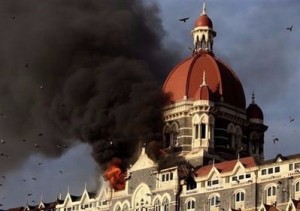 The terrorist attacks in Mumbai — which consisted of blasts in at least seven sites and which apparently targeted Westerners — have, as of this writing, claimed over 110 lives and injured a minimum of 300. Terrorism on this scale has the tendency to engender very common, basic reactions: fear of another attack, concern for those who are at or near the location(s) of the attacks, care for friends or family who may have loved ones affected, disbelief that one set of humans can do this to other humans, and an interest in why the terrorists did what they did. All these elements were present in the wake of 9/11 and the 7/7 bombings, and I believe have been resurrected again with the Mumbai attacks.
The terrorist attacks in Mumbai — which consisted of blasts in at least seven sites and which apparently targeted Westerners — have, as of this writing, claimed over 110 lives and injured a minimum of 300. Terrorism on this scale has the tendency to engender very common, basic reactions: fear of another attack, concern for those who are at or near the location(s) of the attacks, care for friends or family who may have loved ones affected, disbelief that one set of humans can do this to other humans, and an interest in why the terrorists did what they did. All these elements were present in the wake of 9/11 and the 7/7 bombings, and I believe have been resurrected again with the Mumbai attacks.
There is another aspect of a response to mass terrorism that I’d like to discuss in this post: the inclination to unfavorably treat those who share characteristics with or bear resemblance to the terrorists. Following 9/11 and 7/7, Muslims and those perceived to be Muslim were subject to a pervasive and violent backlash. (As we reported earlier this week, Sikhs in America have been profiled in the airport setting.) Accordingly, with news accounts suggesting that the Mumbai terrorists are Muslim, some are worried that Muslims in India may face a wave of public and/or private harassment and discrimination. For example, a colleague who heads a major civil rights organization in America expressed that he was “praying for victims of [the] Mumbai attack[s] and for Muslims in India.”
It should not have to be this way.
A retelling of Heer Ranjha is set to launch in Glasgow this week, and the screenwriters have done a fascinating job of trying to place the classic love story in a contemporary setting.  Instead of the story of two villagers (Ranjha, who leaves his home and is hired by Heer), it’s the story of a Muslim restaurant worker and a Sikh socialite:
Instead of the story of two villagers (Ranjha, who leaves his home and is hired by Heer), it’s the story of a Muslim restaurant worker and a Sikh socialite:
In a fit of depression, [Ranjha] throws himself off the George VI bridge, presumably choosing that one ahead of the Kingston so that the play can continue. He is pulled out of the Clyde by a boatful of partygoers, led by the beautiful Heer, the fast-living daughter of a Glasgow curry magnate and a Sikh. [link]
And, instead of fully morphing the play, the director discussed his desire to speak directly to the Asian population in Glasgow. He integrates a fully Punjabi story into the framework of life experience for Punjabi Scots, including choosing to play the dialogue in local dialect:
“I had been trying for some time to find a story that would attract Asian audiences [Glasgow’s Asian community is primarily Punjabi] and Heer Ranjha was something I had come across very frequently in my discussions with [local] people,” says Lalitha Rajan, artistic director of Ankur Productions. “I wanted to make it relevant and contemporary and I wanted a writer who had an ear for Glaswegian dialect, because it has its own unique linguistic richness. [link]
I think one of the most striking features of this show the opportunity it takes to speak to, and honor, the interconnectedness of the history of Scotland’s Punjabi community within the artistic/social narrative of the U.K. Instead of the story feeling unfamiliar, exotic, or far, it is re-placed to popularize it among youth in the diaspora. Whether this means it’s more risque or departs dramatically from the original, I’m curious to see how it turns out. If any of our readers are Scotland-based, I would love to hear a review if you’re able to go!
Thanksgiving is a time to reflect and celebrate what we are thankful for, rather than commemorate the manipulative actions of the Pilgrims (yes, in many ways this statement makes me feel better when I have my Thanksgiving meal)!
One of the things I am thankful for this year is Barack Obama’s victory as the 44th President-elect of the United States of America. It has been wonderful to be alive to witness this moment in history. As the saying goes, you can only truly value and appreciate yourself if you can also laugh at yourself. So, I will extend this belief to Barack Obama’s presidential win. So, let’s laugh at this satire on Obama supporters (especially if you were one of them  … I know I did)!
… I know I did)!
Have a good Thanks-Giving!

If you haven’t already come across this link, CNN-IBN is streaming live (though the worst of the violence is definitely over).
streaming live (though the worst of the violence is definitely over).
Even by the standards of terrorism in India, which has suffered a rising number of terrorist attacks this year, the assaults were particularly brazen and dramatically different in their scale and execution. Rarely for India, the attackers specifically targeted sites popular with tourists… Unlike previous attacks in India this year, which consisted of anonymously planted bombs, the assailants on Wednesday night were spectacularly well-armed and confrontational.[IHT]
There are still 5 hostages being held in the Oberoi and operations to rescue them are ongoing.
The latest numbers, according to CNN-IBN say 87 killed, 187 injured. Those are, of course, the official numbers. The IHT says preliminary reports say 240 injured.
If you have family and/or friends in the city, I hope they’re safe.
A Sardar friend of mine once recounted his experiences flying soon after 9/11. He was flying within California to a small Central California city. Upon arriving he had to wait for his plane-side check-in luggage and the air-hostess joked that he was lucky to have flown at all. When he asked why, she told him that 2 customers had felt ‘uneasy’ with him on the plane and had they had a third complaint, he would not have been allowed to fly. He asked if he was flying with his three friends, could they report that they felt ‘uneasy’ if they saw a man with a cowboy hat. The air-hostess replied that – that would be a different situation.
that 2 customers had felt ‘uneasy’ with him on the plane and had they had a third complaint, he would not have been allowed to fly. He asked if he was flying with his three friends, could they report that they felt ‘uneasy’ if they saw a man with a cowboy hat. The air-hostess replied that – that would be a different situation.
It seems for 3 “eminent Sikh classical musicians” there situation was not much different than others that flew post 9/11. In a news report that is widely circulating in the Indian press, three Sikh musicians were on board to fly from Sacramento to Salt Lake City on US Airways were asked to deboard the plane after they had cleared proper TSA security clearances, at the whim of the pilot:
The incident occurred after Gulbag, Davinder, and Iqbal Singh cleared Transportation Security Administration (TSA) security and boarded US Airways flight no. 0493 on November 15th in Sacramento, California, on their way to Salt Lake City, Utah. The three were sitting together in the rear of the plane, in their assigned seats. After having been on the plane for approximately ten minutes, they were approached by one of the ticket-reception desk workers and asked to exit the plane. While none of the three adequately comprehend or speak English, the group complied and exited the aircraft. When it became apparent that the group was unable to converse with US Airways representatives, a Panjabi interpreter was called to assist.
Joint Post by Reema and Singh
The Book Club recently commented on the terminology and applicability of the term ‘diaspora’ to the Punjabi community outside Punjab-and whether ‘diaspora’ can apply to a group that won’t be returning to the homeland. For more discussion of the term, check out the Book Club.
We wanted to explore that tangent a little more – the idea of returning to the homeland, and how distant of a reality it actually might be.
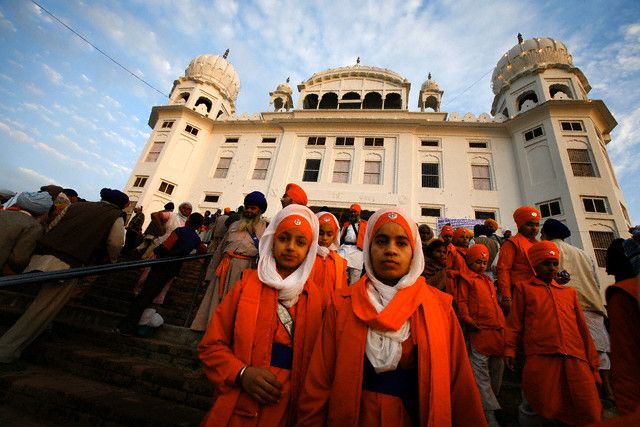
An interesting piece by an Indian-American journalist, who was born in the US and returned to India to write, explores this theme.
It was five years ago that I left America to come live and work in India. Now, in our family and among our Indian-American friends, other children of immigrants are exploring motherland opportunities. The idea is spreading virally through émigré households across the West. [Source]
You might assume that motherland opportunities for foreign-born Sikhs are in the cities – in Bangalore, Mumbai, Delhi, and Chandigarh. And if you’re thinking of business opportunities, that might be true. But Sikhs are drawn to Punjab for a number of reasons: for humanitarian work, community building activities, and unique educational experiences. With a growing number of international organizations like United Sikhs, and in the past Fateh offering opportunities for work and study in Punjab; academies like MiriPiri Academy in Amritsar LINK and Akal Academy at Baru Sahib (in neighboring HP); and foreign universities offer programs tailored to those interested in connected or reconnecting with Punjab – going back to the motherland has become easier than ever.
Gotta love Kim Bolan. For years, the Sikh-Canadian community’s favourite journalist has gotten tremendous mileage from the monikers “moderate” and “fundamentalists” that she has used to describe the BC’s Sikh population. Now, in her reporting of the Guru Nanak Sikh Temple’s election, she’s created a new segment of Sikhs: the “orthodox youth”.
Orthodox youth group sweep all executive positions at Surrey Sikh temple (Link)
I guess just saying “youth group” wouldn’t have been malicious enough. That would have brought up images of young underdog activists who chose to actually make a difference in overcoming tremendous odds in beating a slate of grey-bearded (or no-bearded) uncles who have monopolized our institutions.
Instead, she (and the Vancouver Sun) chose to stick a loaded word in front that insinuates a group that’s rigid, backwards and slightly Talibanistic. Yes, I know the word orthodox technically means “Adhering to the accepted or traditional and established faith” but the textbook definition of fundamentalist is someone who has ” a point of view characterized by a return to fundamental principles”, and that’s not how it was used over the past decade to describe observant Sikhs.
I guess Miss Bolan still has a job to do. If Sikhs actually got along and there was no controversy (real or incited), she’d have nothing to write about.
Watch out Aunties and Uncles, the bachey are taking over the gurdwara!
Surrey, BC – In a historic decision by the Sikh Community of British Columbia, the Sikh Youth slate has been elected to the management committee of Gurdwara Sahib Guru Nanak Sikh Temple in Surrey, BC.
The S
ikh Youth slate of Amardeep Singh with 18 Amritdhari GurSikh members, many of them university students who were born and raised in Canada, won by a resounding margin.
In an official statement on thier web site, the Sikh Youth slate stated:
“The members of Guru Nanak Sikh Temple, Surrey, BC have loudly declared their support for ushering in an era of groundbreaking change and reunion in the Sikh Community of British Columbia by electing the Sikh Youth slate to the management committee of one of North America’s largest historic Gurdwaras.
The entire Sikh Youth campaign wishes to express our heartfelt congratulations to the global Sikh community on this historic achievement which will close divides in our community and create new paths for peace and prosperity for our youth. We could not have accomplished this victory without the hard work and dedication of the many volunteers, campaign staff, and the community who supported us throughout.
With the blessings of God and the Guru, we pledge to serve the entire community with honesty, integrity, universal love and a commitment to the truth.” [Thanks for the info Parveen!]
I know that we Punjabis love importing our culture and traditions to the countries we now call home, but this is getting ridiculous.
Brampton city councillor Vicky Dhillon is on a crusade to stop stores in his area from selling two kinds of decorative poppy flowers, which he said contain addictive opium.
Dhillon said the flowers and stalks are ground into a brownish powder — called doda — that is openly sold for about $10 for 10 grams at about eight meat stores in his Wards 9 and 10. The powder gets a person high when mixed with water and ingested, he said. “This drug is causing a lot of problems in the community,” said the councillor, adding it’s largely used in the Sikh and Hindu communities. His ridings contain more than 100,000 Sikhs.
Dhillon said he’s concerned the use of doda will spread to area schools due to its low cost. Peel Regional Police raided several businesses two weeks ago that were allegedly selling the drug. One man was arrested and 38 kilos of doda seized. Dhillon said he’s raised his concerns with Peel and Brampton city councils and health officials are looking into the problem.
Several varieties of poppies are allowed into Canada as decorative flowers, but only a few have a high opium content. Dhillon is calling for a ban on sales of two specific poppies — Arizona and Holland. “In the last two years, the use of doda has exploded,” he said yesterday. “This is a big threat to the younger people in our community.” Some of the stores selling the “ornamental flowers” were conducting brisk business yesterday. (Link)
I guess I should not be surprised. If drug use is at epidemic levels in Punjab, its naïve to assume people are going to magically clean up their act when the come to Canada. In fact, the culture shock, isolation and life changes that usually come with immigration, probably only make existing drug dependencies worse.
I was always amazed by the number of “meat shops” in Punjabi communities across Canada. I didn’t think there was enough demand for specialized Punjabi meat products to justify the supply. What I hadn’t taken into account was the “premium products” offered at the back of the store.
On the topic of gurdwara construction, the El Sobrante Gurdwara here in the Bay Area recently had its on-site expansion authorized by the county Planning Commission [link]. The gurdwara is located in unincorporated territory, so it’s not controlled directly by city government, and it’s petitioned for expansion plans to be approved for almost 10 years. For a sense of geography, the gurdwara was the first Bay Area facility for a large (and ever-growing) Sikh community, and it’s located on a relatively large site on the face of a huge hill with residential properties above and a commercial and transit corridor at the foot of the hill.
Gurdwara Sahib, the Sikh Center of San Francisco Bay Area, plans to build a community center, performing arts center, museum and parking garage on its 6.5 acre property off Hillcrest Road in unincorporated El Sobrante.
The expansion would add about 70,000 square feet, not counting the garage, to the existing temple’s roughly 22,000 square feet.
I have my own mixed feelings about the expansion, it’s enormity, and the capacity of the site/land to sustain the traffic and population, particularly during an earthquake. That said, the part of the article that really stuck out to me were complaints from local residents, who have opposed the expansion since its first enlargement in the mid-1990s:
Henderson said the commission failed to address his neighbors’ and other El Sobrante Valley residents’ concerns about traffic, noise and the area’s history of landslides, among other environmental concerns.
He also has said that the temple expansion would obstruct homeowners’ views of the Bay among other aesthetic objections, and has called for a full Environmental Impact Report.
“America has elected a black president but it is still business as usual,” Henderson wrote on Wednesday. The commission “has decided that the reasonable requests of the Quail Hill residents are of no concern. “Could it be because the people most affected are primarily black? [emph. mine]
 I recently came across this article, which notes that the construction on a new Sikh gurdwara in the UK is near completion. The cost for the gurdwara is a staggering £11m, all of which has been financed privately by members of the Sikh community.
I recently came across this article, which notes that the construction on a new Sikh gurdwara in the UK is near completion. The cost for the gurdwara is a staggering £11m, all of which has been financed privately by members of the Sikh community.
The article compelled me to think about the growth of gurdwaras in my corner of the United States, where there are now five major gurdwaras within a radius of about 70 miles. It made me think, more fundamentally, about when, and if so under what circumstances, a gurdwara should be built in the West.
Clearly, there are threshold issues that factor into whether a gurdwara should be built, such as whether there is sufficient sangat to initially support the gurdwara and ensure that it is sustainable in the long-term, whether there is available land that is appropriately zoned and in a convenient location, etc. And clearly there are reasons other than a bursting sangat that are invoked to justify the construction of a new gurdwara, such as management conflicts or ideological differences with those in an existing gurdwara. My attention, however, is fixated on one necessary, but not sufficient, requirement with respect to whether a gurdwara should be built: the “staff,” for lack of a better term.
A new contest + award is in place for Sikhs. Who will be the Chic Sikh of the Year for 2008?
The sponsor is Sikhchic, the online magazine which promotes Sikhs in the arts (and also invites articles on an array of subjects). The nomination process is completely transparent, which make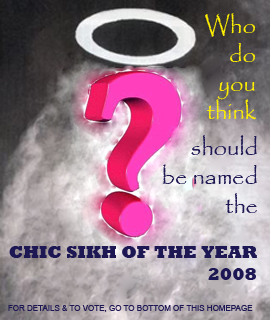 s it interesting. Anyone can nominate by simply entering a nomination and the reasons for it as a comment. It then gets posted, so you can see all of the nominations here. So far, the illustrious nominees include: Prime Minister Manmohan Singh, the Singh Twins, Fauja Singh, Amandeep Singh Madra, and I.J. Singh.
s it interesting. Anyone can nominate by simply entering a nomination and the reasons for it as a comment. It then gets posted, so you can see all of the nominations here. So far, the illustrious nominees include: Prime Minister Manmohan Singh, the Singh Twins, Fauja Singh, Amandeep Singh Madra, and I.J. Singh.
The award doesn’t have to be awarded to a Sikh. It’s unclear how much of a connection a nominee has to have to the Sikh community- whether they have to commit a Sikh-like deed or act to somehow promote/improve the Sikh community. It also doesn’t have to be to a person- it can be to an institution. There are many organizations that have done some really interesting things in the past few years for the Sikh community, and I’m sure we’ll be seeing some of them nominated.
Awards validate ideals- confirm that they mean something. It ‘s unclear so far what ideals this award will recognize since the parameters for nomination have been left purposefully vague. I guess we’ll know more when an awardee is chosen.
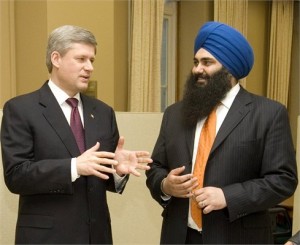 It’s a dark and story night in northern Alberta city of Edmonton. Preparing for a national election that is still months away, the Conservative Party’s riding association in Edmonton-Sherwood is having its nomination meeting. Its not expected to be eventful, as everyone expected local municipal councillor Jacquie Fenske to win by acclamation. On the last day, a young man walks in with his supporters and also declares his intentions to contest the riding on behalf of the Conservative party. He happens to come prepared with more supporters than the surprised Fenske and ends up winning the nomination. A supporter of the exiled Fenske, James Ford contests as an independent but is defeated by the official Conservative candidate as part of an overall minority government win by the Tories.
It’s a dark and story night in northern Alberta city of Edmonton. Preparing for a national election that is still months away, the Conservative Party’s riding association in Edmonton-Sherwood is having its nomination meeting. Its not expected to be eventful, as everyone expected local municipal councillor Jacquie Fenske to win by acclamation. On the last day, a young man walks in with his supporters and also declares his intentions to contest the riding on behalf of the Conservative party. He happens to come prepared with more supporters than the surprised Fenske and ends up winning the nomination. A supporter of the exiled Fenske, James Ford contests as an independent but is defeated by the official Conservative candidate as part of an overall minority government win by the Tories.
You would expect an initial uproar as a young and upcoming catches the old guard off guard, but things should eventually settle down. However, when there’s still protests more than a month after the election, you know there’s more to this story.
So what’s different? A beard and a turban. These articles of the Sikh faith belong to Tim Uppal, a young Sikh activist who has been spent his entire life on the political scene in Edmonton and had previously contested two other elections and lost in a different riding.
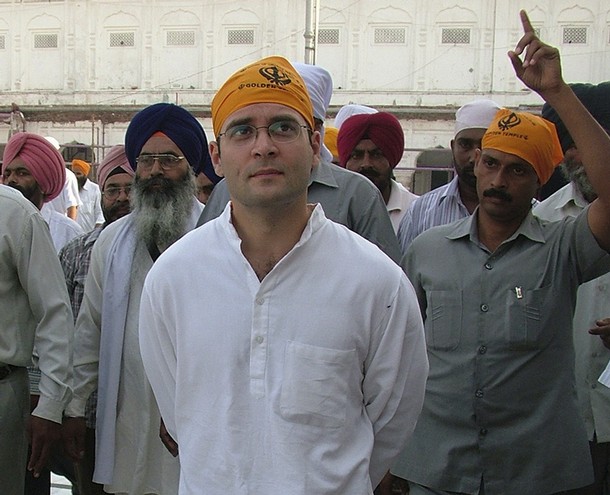
Recently, during a news conference in Amritsar, Rahul Gandhi reportedly condemned the widespread violence which followed his grandmother’s assassination by her bodyguards Satwant Singh and Beant Singh.
The 1984 riots were wrong, and I strongly condemn the carnage…
The comment came in response to a question about Operation Bluestar (SikhiWiki, Sikhipedia, Wikipedia),
What is interesting to me about the reporting is that the media recounting the incident has attached some great significance to the condemnation – as if it means something to the Sikh people that a member of the Gandhi family has openly denounced riots that were obviously wrong and are the cause of so much pain in the Sikh community.
I don’t know that it does. The bottom line is that Rahul Gandhi (son of former Prime Minister Rajiv Gandhi and current Congress Party President Sonia Gandhi) – like his parents, grandmother, great-grandfather, and great-great-grandfather – is a politician and I simply cannot attach much special significance to what he said. As a Sikh I don’t blame Rahul Gandhi for what happened, but I also do not excuse the fact that his father dismissed the riots with comments like “when a big tree falls, the Earth shakes” and that the Indian government has yet to put to justice those who openly instigated and condoned the massacre.
FYI, Rahul went on to explain that neither he nor his family had ill-will towards the Sikh community. Er. Thanks?… I’m sure you sense my sarcasm. So, contrary to what the Indian media may think, Rahul’s comments mean little to me.
Anyhow, I’d like to take this opportunity to promote some media that does mean something to me: The Widow Colony.
For our readers who are not familiar with the film, in short, it is a documentary that presents the stories of a group of Sikh women who lost husbands, sons, and brothers during the anti-Sikh riots of 1984. The film has won numerous accolades and if you have not yet seen it, I highly recommend that you do. And if you are in Northern California – you can see it TOMORROW evening at UC Berkeley.
- What: The Widow Colony
- Where: 2050 VLSB, UC Berkeley, Berkeley, CA 94704
- When: 7:00 pm on Thursday, November 20, 2008
For more info you can email wcberkeley@gmail.com or call 909-802-8892.
[Event poster after the break]

“The first step in liquidating a people is to erase its memory. Destroy its books, its culture, its history. Then have somebody write new books, manufacture a new culture, invent a new history. Before long that nation will begin to forget what it is and what it was… The struggle of man against power is the struggle of memory against forgetting.” – Milan Kundera, The Book of Laughter and Forgetting
Sikhs have never been big on preservation. Partly because we’ve spent most of our 500+ year history fighting for very existence, but in recent years its been a greater combination of complacency, incompetence and real external efforts to mess with our past. All of this has contributed to a situation where, it has been said by some experts, that 80% of Sikh history (architecture, artifacts, texts, etc) has been destroyed in the last 100 years.
According to a 1968 publication of SGPC called ‘sada hath likhat sahit,’ the Sikh Reference Library contained 383 volumes that covered 980 different topics. Amongst this repository were several Hukamn?m?s, 2500 hand-written sarups of Guru Granth Sahib, and other rare historical documents. One historical document was written by Bhai Gurdus and bore a hand-written Mul Mantr page by the Ninth Nanak.
The library also consisted of a manuscript dated 1739 Bikram? that was prepared by Guru Gobind Singh Sahib five years after the martyrdom of Guru Teghbahadur Sahib – in this document, the Tenth Nanak added the writings of the Ninth Nanak at Damdama Sahib to the Guru Granth S?hib.
Unfortunately, the Indian Army set the building on fire on June 7, 1984, destroying a majority of these rare documents. In recent years, the Indian Defense Minister has also admitted to the burning or removal of material from the Sikh Reference Library.
As a young kid, the langar hall was my favourite space in our local Gurdwara. Located in the basement of the building, it was a home away from home. My parents helped build the Gurdwara in the 1970s and I spent many weekends helping with the preparation of Sunday morning langar. I occasionally helped with the cooking, often with the serving and always with the running around. The wide open empty space in the hall provided many hours of fun with playing tag and football with a ball made of tied-up ramaals (handkerchiefs). It was a place to hang out with kids that looked like me and who were going through the same things as me.
As I moved through my late-teens and what I affectionately call my “hard-core” phase, I saw the langar hall as a place serving only two specific functions; serving meals and eating meals (on the floor). Idle social conversation wasn’t what you were going to Gurdwara for. You could do that during the famous multi-family dinner parties that all Punjabi parents dragged their kids to. Gurdwaras were for serious matters and all these people sitting around and gossiping were just taking up valuable time space. Thankfully, I lightened up.
Fast forward a decade (or two) and now, I’ve reconciled my past. Growing up, while I was hanging with other kids who called “jooda time-outs”, the adults were also drinking chaa, talking and sharing stories with other adults. Through the universal acts of serving a meal and sharing a meal, the langar hall became a hub for my local Sikh community.
I’ve seen many an animated conversation in a langar hall. I’ve seen people talk with passion about faith, family, politics, business, sports. In fact, aside from the langar hall, our community has few other forums that provide for all walks of life to come together and share their ideas.
That is why I love that the Langar Hall has gone online. In the same spirit of my community Gurdwara, this site brings together ordinary Sikhs to talk about the issues of the day. The only difference here is that you have to supply your own chaa and mutheai (how the heck do you write that in English? Its worse than paranthas).
I’ve been asked to take on the seva of contributing to this great project. I do not have an English degree from a fancy American university like my illustrious colleagues, in fact I probably should have taken up my Grade One teacher’s offer of English as a Second Language classes. Regardless, I will promise to add another voice to the conversation. Not one that is highly educated or representative of all Sikh-Canadians but one of a second generation Sikh-Canadian born and raised in a country he loves as his own.
Let the gup-shup begin!
Over the past ten years, we’ve seen a resurgence of concern over religious accommodation for Sikh prisoners, witnesses, and the accused, in the American courts.  Four years ago a Sikh inmate starved himself to death. At the time, there were competing stories and speculation over whether this was out of shame, out of fear of being beaten by guards, or for failure to accommodate religious dietary needs.
Four years ago a Sikh inmate starved himself to death. At the time, there were competing stories and speculation over whether this was out of shame, out of fear of being beaten by guards, or for failure to accommodate religious dietary needs.
Since then, at least two recent stories reopen the situation of Sikhs asked to stand at trial or who are incarcerated. In San Jose, a judge has barred a man accused of murder from entering the court room with his turban on, arguing he could hide a noose or other weapon in it:
A San Joaquin County Superior Court judge says a Sikh man facing trial over the murder of his daughter’s former boyfriend will have to appear before jurors without his turban.Judge Charlotte Orcutt says that the long fabric pious men use to wrap their hair could hide a weapon or be used as a noose. [link]
Aside from the abject stupidity of the rationale for disallowing the turban, I was a little floored to see this rationale upheld in the South Bay Area, where there are more than enough Sikhs (including those who have appeared at trial) for the courts to have developed protocols for this, already. The issue extends beyond California, however, to other federal prisons as well:
An American Vietnam War veteran, who converted to Sikhism 20 years ago, has asked President George W. Bush to intervene in protecting the religious rights of a Sikh prisoner in Florida whose hair were cut by prison authorities. [link]
… Tarney said Jagmohan Singh Ahuja’s hair were forcibly cut by officials of the Duval County Jail in Jacksonville, Florida. Ahuja is serving a three year sentence for misdemeanour violations.
The U.S. Supreme Court ruled pretty decisively on the obligation states and the federal government have in allowing for religious practice and accommodation in 2005. What that means in practice, however, hasn’t really translated. Inmates who protested in the 2005 decision were often from “minority” or “non-mainstream” religions (e.g., white supremacists, Wiccans, practitioners of Native American spiritual backgrounds). So then why do Sikhs continue to operate under misunderstandings regarding the inherent harm or potential threat posed by religious practice? The “othering” factor is obvious and easy, but I would argue that their vulnerability is compounded by a lack of language access, lack of representation, and a tenuous relationship between non-incarcerated and incarcerated Sikh populations.
In a recent THL discussion on Prop. 8 we have been addressing the use of Sikh principles in taking a position on homosexual marriage.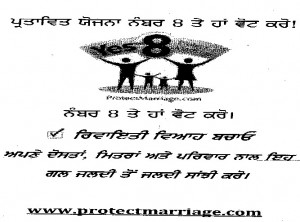 At a recent Nagar Keertan in Yuba City, California there were “Yes on Prop. 8” fliers along with the really interesting T-shirts. Thus, I think religion is an important part of the discussion on Prop. 8 because there is a reason why this state-related material is at religious events. Religion is a moral compass that guides many people’s decisions in all kinds issues. Thus, I don’t condemn those who have used religion as their moral source for voting Yes or No on Prop. 8. However, I do disagree with how Sikh scripture has been misused as “rules” rather than concepts that guide our decisions. I attribute these actions to a general lack of understanding and education around the Guru Granth Sahib Ji in our community. This education is a fundamental issue we as a Quam need to find practical solutions for rather than blame people for not knowing.
At a recent Nagar Keertan in Yuba City, California there were “Yes on Prop. 8” fliers along with the really interesting T-shirts. Thus, I think religion is an important part of the discussion on Prop. 8 because there is a reason why this state-related material is at religious events. Religion is a moral compass that guides many people’s decisions in all kinds issues. Thus, I don’t condemn those who have used religion as their moral source for voting Yes or No on Prop. 8. However, I do disagree with how Sikh scripture has been misused as “rules” rather than concepts that guide our decisions. I attribute these actions to a general lack of understanding and education around the Guru Granth Sahib Ji in our community. This education is a fundamental issue we as a Quam need to find practical solutions for rather than blame people for not knowing.
That said, I believe a fundamental part of Sikhi is love … the morality of love. It’s not the happy happy love or perfect one that excuses all actions, but the one that makes us human enough to see the light of Waheguru in all …. even those we detest. What is this love … I think Khalil Gibran poignantly explains it in his book “The Prophet”:
“For even as love crowns you so shall he crucify you. Even as he is for your growth so is he for your pruning. Even as he ascends to your height and caresses your tenderest branches that quiver in the sun, so shall he descend to your roots and shake them in their clinging to the earth.”
A movie you might be interested in, Slumdog Millionaire, is being released in major cities today and most other North American cities throughout the next few weeks. The plot might sound corny to the skeptical (it involves some romance), but if it’s as well done as it seems to be from the trailer, it could be one of those poignant, moving films that only come along once every few years (in the genre of Born into Brothels). The trailer gives away a lot, so if you like to be surprised, don’t watch all (or any) of it. (The skeptic in me is hoping it’s not a touristy, voyeuristic ride into areas that most movie-goers will only go to through the movie…)

An interesting theme that came up in the making of the movie is product displacement. Apparently Mercedes and “a well known soft drinks company” objected to their products being shown in a slum and demanded that their logos be removed, which was done digitally, costing tens of thousands of pounds. Yet, the Benz folks were perfectly happy having their logo appear on a gangster’s car when it was parked outside his mansion. So it’s ok to engage in mass (probably violent) crime as long as you’re wealthy. Mercedes will hang with you. But if you want to try to earn an honest living, and just can’t make it out of poverty- sorry, no such luck. [Timesonline]
The car manufacturer and a well-known soft drinks company believed that their brands would be sullied if their products were shown in one of Bombay’s shantytowns. [Timesonline]
Hey, Mercedes and fizzy drink company- you may have missed one of the points of the movie-you know, here’s the human struggle and spirit, from the eyes of someone you didn’t realize you had so much in common with??… Never mind. (I’m trying to not let their stupidity ruin the movie for me.)
More absurdity, synopsis and release dates below the fold.
In the spirit of offering profiles of Sikh communities around the world, I wanted to share this article on a small but thriving Sikh community in Argentina:
The Sikhs originally came to Argentina in the early 19th century to work on a British-built railroad. Later, in the 1970s, others came after being barred entry to Canada and the United States, the preferred destinations, along with Britain, for the emigrants.
At the time, Argentina seemed the most promising of South American nations, and so they stayed, eventually concentrating in the north, which reminded them of the scrappy mountains and plains of Punjab.
Today, there are 300 of them, many of whom run supermarkets and other shops.
The article highlights the solo Sikh gurdwara in Argentina and the prevalence of interreligious marriages. The Catholic-Sikh connection parallels, in part, the history of Latino-Punjabi (Catholic-Sikh) marriages in California during the Asian Exclusion Act years. The small community fears, however, that practice will continually erode, especially with the high out-marriage rate:
Mixed marriages with Catholic Argentines are common. Although they are increasingly integrated, the temple is an emblem of their adherence to their roots….
The marriages to non-Sikh Argentines means “keeping one’s religion becomes almost impossible,” he said, adding: “I think the third generation is the one that will lose the most.”
I thought this was an interesting divergence, because other small Sikh communities in other countries continue to thrive and maintain their identity. Perhaps one of the key differences is the religious diversity among immigrants or within the country itself? (although how that would apply to Catholic Italy is an open question).


